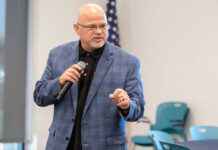By Nancy Smith
Gridlock on SR 347! Yes, that’s what I said. We who live in Maricopa need to be aware of the fact that a study in late 2015, the Maricopa Area Transportation Plan-Phase I, indicated that SR 347 was going to experience ‘significant congestion’ by 2017, deteriorating to ‘Roadway Facility Failure’ by 2028 if nothing is done to mitigate the traffic problem. Furthermore, the study found that with a third lane added in each direction between north Maricopa City Limits and I-10, SR 347 could potentially avoid ‘significant congestion’ until 2023.
Shortly after hearing that during a city council meeting I put a project on the council project list called ‘Get Ahead of SR347 GRIDLOCK.” Later, I met a man who serves on the Wild Horse Pass Development Authority for the Gila River Indian Community and asked if he, I and our city manager could meet to discuss this study. We met, and all agreed this is a problem that will need a solution as soon as possible. This is a serious concern for me and I’m sure for most residents who use SR 347 to get to work every weekday.
Recently, a city council candidate published his concerns regarding voter support of the Regional Transportation Authority (RTA). He states, “I have spoken with engineers, ADOT representatives, and former City employees about the project.” While I respect his concerns and questions, I have a concern that he spoke to groups to gain information without speaking with the two groups that have the most recent information and have been working the scope, timeline, partners, and studies that have already begun.
With the exception of ADOT, none of his other sources has any insight in the work already completed for this project. He should have spoken with the originators of the RTA, Pinal County, and he most definitely should have spoken with the City of Maricopa Planning Division to gain knowledge on how they’ve been working this project. These two, City of Maricopa and Pinal County, have the most recent information available to help make an informed decision. Our city transportation planner and Planning Division, along with the consultant who identified the looming traffic problems on SR 347, take this seriously and have been actively working to organize and take action with national standards in planning processes and establishing the right partnerships.
My opponent says, “If elected, one of my priorities will be working with the Arizona Department of Transportation (ADOT), Pinal County, Gila River Indian Community (GRIC), Maricopa Association of Governments (MAG) and others to improve (widen) SR 347…” and he says “The time to begin planning for expansion and improvements is now.” Again, the partnerships have been established and the planning for expansion and improvements has already begun!
I feel it is very important to keep the voters informed of the most recent information on this project. Had my opponent spoken with any of these organizations and/or the City of Maricopa Planning Division he would have found out that these discussions and partnerships are already taking place. He would have also found out that his concerns are being addressed.
As an example, it is true that the ADOT’s Roadway Design Guidelines only allow for certain conditions on projects. The evaluation of these conditions happens during the design phase of the project, which would be paid for with the revenue generated from the RTA. This is a very expensive phase of the project and one that the City of Maricopa would not want to fund out of our Capital Improvement funds. The design phase would determine if there are any roadblocks. However, based on my research, there are many creative engineering methods for resolving conditions to meet the guidelines that will allow for turn lanes and a safe buffer without compromising traffic flow and safety.
Another example of what the design phase would strive to resolve relates to his concern regarding “increased signalization” and slowing down traffic flow. One of the main goals of increasing SR 347 from four lanes to six lanes is to decrease GRIDLOCK, not increase GRIDLOCK. The design phase would strive to reach that goal and would likely include grade separated intersections at Casa Blanca Road, Riggs Road and a free flow on-ramp to I-10.
A last example is the concern over the Gila River Indian Community Easement Agreement. I agree, there is concern over changing the Easement Agreement and it will take time, collaboration, communication and cooperation, all of which are underway. As mentioned above, the city manager and I have started these discussions and our mayor has continued the discussions, in addition to staff coordinating the beginning stage with Gila River Indian Community.
My opponent closes his article with the option to “build a grade-separated crossing – a bridge to keep north/southbound traffic moving.” He goes on to say, “The same may need to be done at the I-10 interchange.” This portion of the SR 347 resides within Maricopa County. Obviously, many Pinal County taxpayers may have severe heart burn using revenue raised in Pinal County on a Maricopa County portion of the project. However, with MAG and Maricopa County as partners, that could be considered part of the solution, but not at the expense of increasing SR 347 lanes from four to six.
My philosophy as your city council member is to work with facts. The facts are that the Maricopa Area Transportation Plan-Phase I of December 2015 indicates that SR 347 is going to experience ‘significant congestion’ by 2017. The City of Maricopa Planning Division and Pinal County have already begun establishing the partners and relationships to make wise decisions on the SR347 and RTA. The RTA provides the revenue to begin the design phase in the quickest amount of time. Alternative routes would take significantly more time and revenue. Consider the time that has been needed for our own SR 347 overpass at the railroad track, it’s been over 10 years. Alternative routes would take significantly more time than adding lanes to SR 347 because SR 347 already exists and needs a modification to the GRIC Easement Agreement; whereas a completely new route requires purchasing new right-of-ways, new GRIC agreements, new agreements with other land owners, etc.
My opponent’s vote on the RTA is as follows in his own words, “Before we ask the voters to approve a 20-year sales tax increase, let’s make sure we can deliver improved transportation…”.
That’s going to be too late! The RTA revenue language can be modified to include a ‘Firewall’ for Maricopa funds, as was included in Maricopa County’s Prop 400. A ‘Firewall’ protects designated funds for a community in the event that the named project proves non-viable for any reason, which basically means the funds would still be used for a different transportation project that benefits Maricopa. With the design phase included as part of the RTA and with the city not having a surplus of money needed to pay for the very expensive design phase, I believe when the opportunity to vote on this proposition in early 2017 comes to the voters, we should vote ‘yes’ to minimize the impact of GRIDLOCK as quickly as possible.
Nancy Smith is a member of the Maricopa City Council and a candidate for re-election.

















